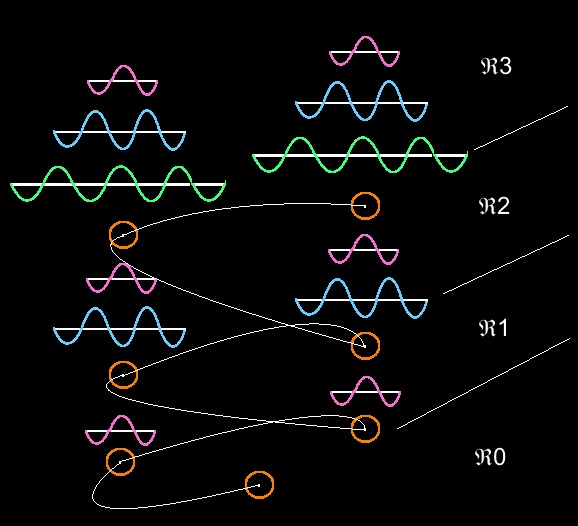
Both the micro and macrocanonical ensembles: {x,y,z,t} exist in our world. The world itself exists on the boundary of manifest and unmanifest reality as per:
The Creation
1. The set cardinality is 4. These orthogonal dimensions are 3 of space and 1 of time. In the macroset, the spacetime event is approximately measurable. That is: {x,y,z,t} are approximately independent (connected as light speed is approached as per special relativity). In the microset, the spacetime event is entangled (maximally indistinguishable although time is always maximally orthogonal to space). That is: chemical reactions are mediated by photonic exchange. Within and between these aspects of manifest reality do Gravity, Electricity, Uncertainty and Entropy act.
2. One (eigenstate) in the [mass] potential, or unmanifest
Ψmass is formless: ∃¬(Ψi)|[(Ψi ⊂ Ψmass)^(aΨi ≠ Ψmass)] a ∈ ℜ
That is, the potential space of mass exists outside of realized reality, or ‘elsewhere’. This unobservable realm has one unique eigenstate. Within this and between this and the manifest realm do Gravity and Uncertainty act, (n.b.: this Uncertainty is twofold, additionally subject to exclusionary principles of the subordinate manifest realm (3) and not equivalent to the unmanifest quantum state exclusion). That is: the unmanifest realm exists above the manifest). Descent from unmanifest to manifest is thus precluded by the massive arrangements of the manifest. I.e.: the shape of the Milky Way Galaxy is not independent of itself.
3. Fermion Quantum State Exclusion
Within both manifest and unmanifest realms, two different fermionic waveforms cannot occupy the same quantum state.
4. The Law of Entropy governs all transitions.
δ(S) ≥ 0
For all of observable creation, dt ⇒ dS.
5. The microcanonical electric manifestation (the Periodic Table) is dualistic (electrons occur in pairs, or: the microcanonical spacetime event is permeated dualistically).
This system contains 1 time event in the first S-Orbital atop which rest three subsequent time events: rows 2-3 (ℜ1), 4-5(ℜ2) and 6-7(ℜ3).

Both the initiator event (t of ℜ0) and subsequent spatial events (t of ℜ1, 2 and 3) are intrinsically dualistic. Additionally, the subsequent spatial events are consequently dual. The physical dimensions (ℜ1,2,3) above the initiator event (ℜ0) are dual both inherently and consequent to said event, that is the initial creator event is different from the subsequent spatial events.
6. One duality in ℜ0 and two squares of duality per nested microcanonical physical dimension.
In the first (and subsequent) event is time, in the subsequent dimensions are space. An individual waveform is in permanent vibration (potential) and thus subject to the waveform exclusionary (Uncertainty) principles of the microcanonical ensemble (spacetemporal dimensions) in which it vibrates.
∀ i ∈ {0,1,2,3}, ∀ j ∈ {0,1,2}, ∃ (ΔpiΔxi)| (ΔpiΔxi)≥ ℏ|ℜj⊂≠ℜj+1}
Thank You

Does the duality aspect of electroms include the notion that an electron contains infinite potential of what it could become, which creates infinite limitation as to what it cannot become, as well?
LikeLiked by 1 person
no, the duality has to do with the nature of reality as it pertains to quantum state exclusion. since (by observation) 2 electrons can occupy the same physical orbital subshell, they are dual in the sense that if they were not then 2 electrons could not exist in the same subshell (which we do not observe).
an electron can only ever be an electron but its state variables can change, such as the electropotential distribution when there is interference at a slit. this causes the spacelike parameters of the electron to become reduced in accordance with the measurement limit
LikeLike
Thank you so much. You are truly awesome.
Would it be true that an electron by itself could be said to possess unlimited potential, in the sense that it could be used to form any number of elements, say hydrogen, for instance, which could then go on to become water or oil, etc., and for every atom and molecule this electron has the potential to form, it would also be excluded from an infinite number of other elements and molecules? (Akin to the circle and point analogy?)
Thank you for your consideration. Many blessings to you.
LikeLiked by 1 person
Yes an electron possesses unlimited bonding potential. And yes, such a bond excludes it from other molecular potentials. However, we must recall that electron potentials exist primarily within the boundaries set forth by the Measurement Limit, not the chemical binding potential (itself a subset of the total ML potential function, but not equal to it). Similarly, the circle and point analogy, while sometimes useful, is ultimately reductionist. The only true grand paramacrocanonical modelization function is the one which predicts all states. sadly such is not able to be conceptually transcended in any form. However, by modelization, we can locally overcome the limitations of even the measurement limit (to within reasonable causality) and thus even which cannot be transcended can be known to arbitrary precision: the gift of the fractal harmonic nature of causality!)
LikeLike
Such a gift. So beautiful. It is all starting to come back to me the more I read your words. 😉
This Knowledge is what I live, and now I am going to use this language to define what I already know, what once was, but was forgotten – temporarily.
LikeLike
blessings my friend ❤
LikeLike